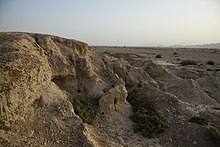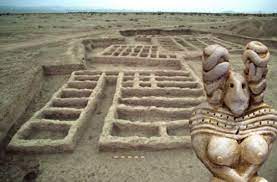Mehrgarh: "Mehrgarh's Archaeological Treasures: Unveiling South Asia's Past"
MEHRGARH!!
Mehrgarh is a Neolithic archaeological site (dated c. 7000 BCE – c. 2500/2000 BCE) situated on the Kacchi Plain of Balochistan in Pakistan.[1] It is located near the Bolan Pass, to the west of the Indus River and between the modern-day Pakistani cities of Quetta, Kalat and Sibi. The site was discovered in 1974 by the French Archaeological Mission[2] led by the French archaeologists Jean-François Jarrige and his wife, Catherine Jarrige. Mehrgarh was excavated continuously between 1974 and 1986,[3] and again from 1997 to 2000.[4] Archaeological material has been found in six mounds, and about 32,000 artifacts have been collected from the site. The earliest settlement at Mehrgarh—located in the northeast corner of the 495-acre (2.00 km2) site—was a small farming village dated between 7000 BCE and 5500 BCE.
History[edit]
Mehrgarh is the earliest known site in South Asia showing evidence of farming and herding.[5][6][note 1] It was influenced by the Neolithic culture of the Near East,[16] with similarities between "domesticated wheat varieties, early phases of farming, pottery, other archaeological artefacts, some domesticated plants and herd animals."[17][note 2] According to Asko Parpola , the culture migrated into the Indus Valley and became the Indus Valley Civilisation of the Bronze Age.[18]
Jean-Francois Jarrige argues for an independent origin of Mehrgarh. Jarrige notes "the assumption that farming economy was introduced full-fledged from Near-East to South Asia,"[19][note 2] and the similarities between Neolithic sites from eastern Mesopotamia and the western Indus Valley, which are evidence of a "cultural continuum" between those sites. However, given the originality of Mehrgarh, Jarrige concludes that Mehrgarh has an earlier local background," and is not a "'backwater' of the Neolithic culture of the Near East."[19]
Lifestyle and technology[edit]
Early Mehrgarh residents lived in mud brick houses, stored their grain in granaries, fashioned tools with local copper ore, and lined their large basket containers with bitumen. They cultivated six-row barley, einkorn and emmer wheat, jujubes and dates, and herded sheep, goats and cattle. Residents of the later period (5500 BCE to 2600 BCE) put much effort into crafts, including flint knapping, tanning, bead production, and metal working.[53] Mehrgarh is probably the earliest known center of agriculture in South Asia.[54]
The oldest known example of the lost-wax technique comes from a 6,000-year-old wheel-shaped copper amulet found at Mehrgarh. The amulet was made from unalloyed copper, an unusual innovation that was later abandoned.[55]
Artifacts[edit]

Human figurines[edit]
The oldest ceramic figurines in South Asia were found at Mehrgarh. They occur in all phases of the settlement and were prevalent even before pottery appears. The earliest figurines are quite simple and do not show intricate features. However, they grow in sophistication with time, and by 4000 BC begins to show their characteristic hairstyles and typical prominent breasts. All the figurines up to this period were female. Male figurines appear only from period VII and gradually become more numerous. Many of the female figurines are holding babies, and were interpreted as depictions of the "mother goddess". However, due to some difficulties in conclusively identifying these figurines with the "mother goddess", some scholars prefer using the term "female figurines with likely cultic significance".[57][58][59]
-WOOW MOTHER GODDESS::000
History[edit]
Mehrgarh is the earliest known site in South Asia showing evidence of farming and herding.[5][6][note 1] It was influenced by the Neolithic culture of the Near East,[16] with similarities between "domesticated wheat varieties, early phases of farming, pottery, other archaeological artefacts, some domesticated plants and herd animals."[17][note 2] According to Asko Parpola , the culture migrated into the Indus Valley and became the Indus Valley Civilisation of the Bronze Age.[18]
Jean-Francois Jarrige argues for an independent origin of Mehrgarh. Jarrige notes "the assumption that farming economy was introduced full-fledged from Near-East to South Asia,"[19][note 2] and the similarities between Neolithic sites from eastern Mesopotamia and the western Indus Valley, which are evidence of a "cultural continuum" between those sites. However, given the originality of Mehrgarh, Jarrige concludes that Mehrgarh has an earlier local background," and is not a "'backwater' of the Neolithic culture of the Near East."[19]

Lukacs and Hemphill suggest an initial local development of Mehrgarh, with continuity in cultural development but a population change.[35] According to Lukacs and Hemphill, while there is a strong continuity between the Neolithic and Chalcolithic cultures of Mehrgarh, dental evidence shows that the Chalcolithic population did not descend from the Neolithic population of Mehrgarh,[36] which "suggests moderate levels of gene flow."[36] They wrote that "the direct lineal descendants of the Neolithic inhabitants of Mehrgarh are to be found to the south and the east of Mehrgarh, Pakistan in northwestern India and the western edge of the Deccan Plateau," with Neolithic Mehrgarh showing greater affinity with Chalcolithic Inamgaon, south of Mehrgarh, than with Chalcolithic Mehrgarh. [36][note 3]
Gallego Romero et al. (2011) state that their research on lactose tolerance in India suggests that "the west Eurasian genetic contribution identified by Reich et al. (2009) principally reflects gene flow from Pakistan, Iran and the Middle East."[39] Gallego Romero notes that Indians who are lactose-tolerant show a genetic pattern regarding this tolerance which is "characteristic of the common European mutation."[40] According to Romero, this suggests that "the most common lactose tolerance mutation made a two-way migration out of the Middle East less than 10,000 years ago. While the mutation spread across Europe, another explorer must have brought the mutation eastward to India – likely traveling along the coast of the Persian Gulf where other pockets of the same mutation have been found."[40] They further note that "[t]he earliest evidence of cattle herding in south Asia comes from the Indus River Valley site of Mehrgarh and is dated to 7,000 YBP."[39][note 4]
Publisher: Arashel
Source: https://en.wikipedia.org/wiki/Mehrgarh

Comments
Post a Comment